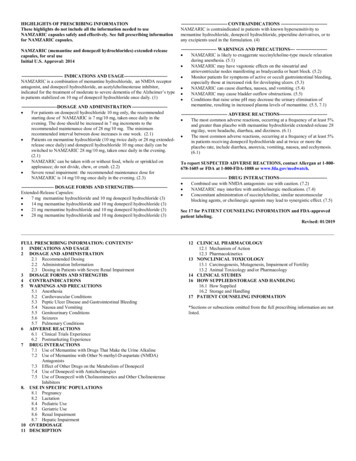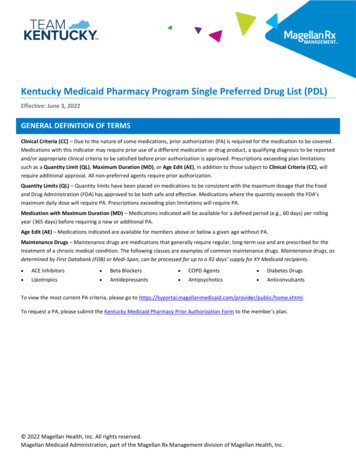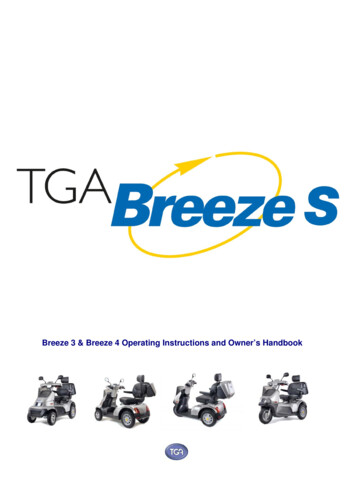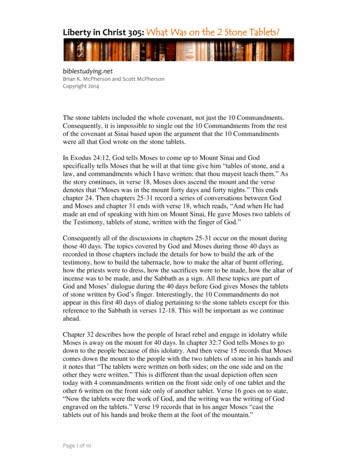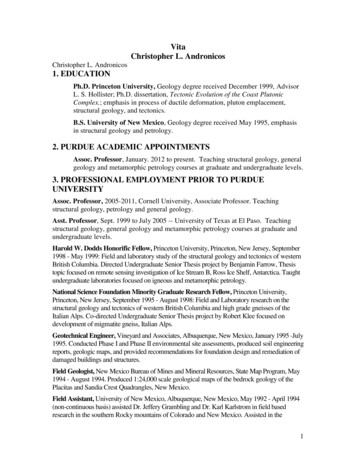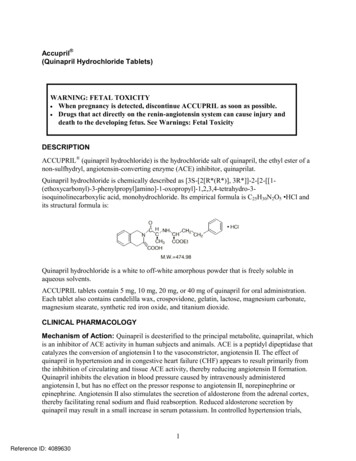
Transcription
Accupril (Quinapril Hydrochloride Tablets)WARNING: FETAL TOXICITY When pregnancy is detected, discontinue ACCUPRIL as soon as possible. Drugs that act directly on the renin-angiotensin system can cause injury anddeath to the developing fetus. See Warnings: Fetal ToxicityDESCRIPTIONACCUPRIL (quinapril hydrochloride) is the hydrochloride salt of quinapril, the ethyl ester of anon-sulfhydryl, angiotensin-converting enzyme (ACE) inhibitor, quinaprilat.Quinapril hydrochloride is chemically described as [3S-[2[R*(R*)], rboxylic acid, monohydrochloride. Its empirical formula is C25H30N2O5 HCl andits structural formula is:Quinapril hydrochloride is a white to off-white amorphous powder that is freely soluble inaqueous solvents.ACCUPRIL tablets contain 5 mg, 10 mg, 20 mg, or 40 mg of quinapril for oral administration.Each tablet also contains candelilla wax, crospovidone, gelatin, lactose, magnesium carbonate,magnesium stearate, synthetic red iron oxide, and titanium dioxide.CLINICAL PHARMACOLOGYMechanism of Action: Quinapril is deesterified to the principal metabolite, quinaprilat, whichis an inhibitor of ACE activity in human subjects and animals. ACE is a peptidyl dipeptidase thatcatalyzes the conversion of angiotensin I to the vasoconstrictor, angiotensin II. The effect ofquinapril in hypertension and in congestive heart failure (CHF) appears to result primarily fromthe inhibition of circulating and tissue ACE activity, thereby reducing angiotensin II formation.Quinapril inhibits the elevation in blood pressure caused by intravenously administeredangiotensin I, but has no effect on the pressor response to angiotensin II, norepinephrine orepinephrine. Angiotensin II also stimulates the secretion of aldosterone from the adrenal cortex,thereby facilitating renal sodium and fluid reabsorption. Reduced aldosterone secretion byquinapril may result in a small increase in serum potassium. In controlled hypertension trials,1Reference ID: 4089630
treatment with ACCUPRIL alone resulted in mean increases in potassium of 0.07 mmol/L (seePRECAUTIONS). Removal of angiotensin II negative feedback on renin secretion leads toincreased plasma renin activity (PRA).While the principal mechanism of antihypertensive effect is thought to be through the reninangiotensin-aldosterone system, quinapril exerts antihypertensive actions even in patients withlow renin hypertension. ACCUPRIL was an effective antihypertensive in all races studied,although it was somewhat less effective in blacks (usually a predominantly low renin group) thanin nonblacks. ACE is identical to kininase II, an enzyme that degrades bradykinin, a potentpeptide vasodilator; whether increased levels of bradykinin play a role in the therapeutic effect ofquinapril remains to be elucidated.Pharmacokinetics and Metabolism: Following oral administration, peak plasma quinaprilconcentrations are observed within one hour. Based on recovery of quinapril and its metabolitesin urine, the extent of absorption is at least 60%. The rate and extent of quinapril absorption arediminished moderately (approximately 25–30%) when ACCUPRIL tablets are administeredduring a high-fat meal. Following absorption, quinapril is deesterified to its major activemetabolite, quinaprilat (about 38% of oral dose), and to other minor inactive metabolites.Following multiple oral dosing of ACCUPRIL, there is an effective accumulation half-life ofquinaprilat of approximately 3 hours, and peak plasma quinaprilat concentrations are observedapproximately 2 hours post-dose. Quinaprilat is eliminated primarily by renal excretion, up to96% of an IV dose, and has an elimination half-life in plasma of approximately 2 hours and aprolonged terminal phase with a half-life of 25 hours. The pharmacokinetics of quinapril andquinaprilat are linear over a single-dose range of 5–80 mg doses and 40–160 mg in multiple dailydoses. Approximately 97% of either quinapril or quinaprilat circulating in plasma is bound toproteins.In patients with renal insufficiency, the elimination half-life of quinaprilat increases as creatinineclearance decreases. There is a linear correlation between plasma quinaprilat clearance andcreatinine clearance. In patients with end-stage renal disease, chronic hemodialysis or continuousambulatory peritoneal dialysis has little effect on the elimination of quinapril and quinaprilat.Elimination of quinaprilat may be reduced in elderly patients ( 65 years) and in those with heartfailure; this reduction is attributable to decrease in renal function (see DOSAGE ANDADMINISTRATION). Quinaprilat concentrations are reduced in patients with alcoholic cirrhosisdue to impaired deesterification of quinapril. Studies in rats indicate that quinapril and itsmetabolites do not cross the blood-brain barrier.Pharmacodynamics and Clinical EffectsHypertension: Single doses of 20 mg of ACCUPRIL provide over 80% inhibition of plasmaACE for 24 hours. Inhibition of the pressor response to angiotensin I is shorter-lived, with a 20mg dose giving 75% inhibition for about 4 hours, 50% inhibition for about 8 hours, and 20%inhibition at 24 hours. With chronic dosing, however, there is substantial inhibition ofangiotensin II levels at 24 hours by doses of 20–80 mg.Administration of 10 to 80 mg of ACCUPRIL to patients with mild to severe hypertensionresults in a reduction of sitting and standing blood pressure to about the same extent with2Reference ID: 4089630
minimal effect on heart rate. Symptomatic postural hypotension is infrequent although it canoccur in patients who are salt-and/or volume-depleted (see WARNINGS). Antihypertensiveactivity commences within 1 hour with peak effects usually achieved by 2 to 4 hours after dosing.During chronic therapy, most of the blood pressure lowering effect of a given dose is obtained in1–2 weeks. In multiple-dose studies, 10–80 mg per day in single or divided doses loweredsystolic and diastolic blood pressure throughout the dosing interval, with a trough effect of about5–11/3–7 mm Hg. The trough effect represents about 50% of the peak effect. While the doseresponse relationship is relatively flat, doses of 40–80 mg were somewhat more effective attrough than 10–20 mg, and twice daily dosing tended to give a somewhat lower trough bloodpressure than once daily dosing with the same total dose. The antihypertensive effect ofACCUPRIL continues during long-term therapy, with no evidence of loss of effectiveness.Hemodynamic assessments in patients with hypertension indicate that blood pressure reductionproduced by quinapril is accompanied by a reduction in total peripheral resistance and renalvascular resistance with little or no change in heart rate, cardiac index, renal blood flow,glomerular filtration rate, or filtration fraction.Use of ACCUPRIL with a thiazide diuretic gives a blood-pressure lowering effect greater thanthat seen with either agent alone.In patients with hypertension, ACCUPRIL 10–40 mg was similar in effectiveness to captopril,enalapril, propranolol, and thiazide diuretics.Therapeutic effects appear to be the same for elderly ( 65 years of age) and younger adultpatients given the same daily dosages, with no increase in adverse events in elderly patients.Heart Failure: In a placebo-controlled trial involving patients with congestive heart failuretreated with digitalis and diuretics, parenteral quinaprilat, the active metabolite of quinapril,reduced pulmonary capillary wedge pressure and systemic vascular resistance and increasedcardiac output/index. Similar favorable hemodynamic effects were seen with oral quinapril inbaseline-controlled trials, and such effects appeared to be maintained during chronic oralquinapril therapy. Quinapril reduced renal hepatic vascular resistance and increased renal andhepatic blood flow with glomerular filtration rate remaining unchanged.A significant dose response relationship for improvement in maximal exercise tolerance has beenobserved with ACCUPRIL therapy. Beneficial effects on the severity of heart failure as measuredby New York Heart Association (NYHA) classification and Quality of Life and on symptoms ofdyspnea, fatigue, and edema were evident after 6 months in a double-blind, placebo-controlledstudy. Favorable effects were maintained for up to two years of open label therapy. The effects ofquinapril on long-term mortality in heart failure have not been evaluated.INDICATIONS AND USAGEHypertensionACCUPRIL is indicated for the treatment of hypertension, to lower blood pressure. Loweringblood pressure reduces the risk of fatal and nonfatal cardiovascular events, primarily strokes andmyocardial infarctions. These benefits have been seen in controlled trials of antihypertensivedrugs from a wide variety of pharmacologic classes including the class to which this drugprincipally belongs. There are no controlled trials demonstrating risk reduction with ACCUPRIL.3Reference ID: 4089630
Control of high blood pressure should be part of comprehensive cardiovascular risk management,including, as appropriate, lipid control, diabetes management, antithrombotic therapy, smokingcessation, exercise, and limited sodium intake. Many patients will require more than one drug toachieve blood pressure goals. For specific advice on goals and management, see publishedguidelines, such as those of the National High Blood Pressure Education Program’s JointNational Committee on Prevention, Detection, Evaluation, and Treatment of High BloodPressure (JNC).Numerous antihypertensive drugs, from a variety of pharmacologic classes and with differentmechanisms of action, have been shown in randomized controlled trials to reduce cardiovascularmorbidity and mortality, and it can be concluded that it is blood pressure reduction, and not someother pharmacologic property of the drugs, that is largely responsible for those benefits. Thelargest and most consistent cardiovascular outcome benefit has been a reduction in the risk ofstroke, but reductions in myocardial infarction and cardiovascular mortality also have been seenregularly.Elevated systolic or diastolic pressure causes increased cardiovascular risk, and the absolute riskincrease per mmHg is greater at higher blood pressures, so that even modest reductions of severehypertension can provide substantial benefit. Relative risk reduction from blood pressurereduction is similar across populations with varying absolute risk, so the absolute benefit isgreater in patients who are at higher risk independent of their hypertension (for example, patientswith diabetes or hyperlipidemia), and such patients would be expected to benefit from moreaggressive treatment to a lower blood pressure goal.Some antihypertensive drugs have smaller blood pressure effects (as monotherapy) in blackpatients, and many antihypertensive drugs have additional approved indications and effects (e.g.,on angina, heart failure, or diabetic kidney disease). These considerations may guide selection oftherapy.ACCUPRIL may be used alone or in combination with thiazide diuretics.Heart FailureACCUPRIL is indicated in the management of heart failure as adjunctive therapy when added toconventional therapy including diuretics and/or digitalis.In using ACCUPRIL, consideration should be given to the fact that another ACE inhibitor,captopril, has caused agranulocytosis, particularly in patients with renal impairment or collagenvascular disease. Available data are insufficient to show that ACCUPRIL does not have a similarrisk (see WARNINGS).Angioedema in black patients: Black patients receiving ACE inhibitor monotherapy havebeen reported to have a higher incidence of angioedema compared to non-blacks. It should alsobe noted that in controlled clinical trials ACE inhibitors have an effect on blood pressure that isless in black patients than in non-blacks.CONTRAINDICATIONSACCUPRIL is contraindicated in patients who are hypersensitive to this product and in patientswith a history of angioedema related to previous treatment with an ACE inhibitor.4Reference ID: 4089630
ACCUPRIL is contraindicated in combination with a neprilysin inhibitor (e.g., sacubitril). Do notadminister ACCUPRIL within 36 hours of switching to or from sacubitril/valsartan, a neprilysininhibitor (see WARNINGS and PRECAUTIONS).Do not co-administer ACCUPRIL with aliskiren in patients with diabetes.WARNINGSAnaphylactoid and Possibly Related ReactionsPresumably because ACE inhibitors affect the metabolism of eicosanoids and polypeptides,including endogenous bradykinin, patients receiving ACE inhibitors (including ACCUPRIL)may be subject to a variety of adverse reactions, some of them serious.Head and Neck Angioedema: Angioedema of the face, extremities, lips, tongue, glottis, andlarynx has been reported in patients treated with ACE inhibitors and has been seen in 0.1% ofpatients receiving ACCUPRIL.In two similarly sized U.S. postmarketing trials that, combined, enrolled over 3,000 blackpatients and over 19,000 non-blacks, angioedema was reported in 0.30% and 0.55% of blacks (instudy 1 and 2 respectively) and 0.39% and 0.17% of non-blacks.Angioedema associated with laryngeal edema can be fatal. If laryngeal stridor or angioedema ofthe face, tongue, or glottis occurs, treatment with ACCUPRIL should be discontinuedimmediately, the patient treated in accordance with accepted medical care, and carefully observeduntil the swelling disappears. In instances where swelling is confined to the face and lips, thecondition generally resolves without treatment; antihistamines may be useful in relievingsymptoms. Where there is involvement of the tongue, glottis, or larynx likely to causeairway obstruction, emergency therapy including, but not limited to, subcutaneousepinephrine solution 1:1000 (0.3 to 0.5 mL) should be promptly administered (seeADVERSE REACTIONS).Patients taking concomitant mammalian target of rapamycin (mTOR) inhibitor (e.g.,temsirolimus) therapy or a neprilysin inhibitor may be at increased risk for angioedema.Intestinal Angioedema: Intestinal angioedema has been reported in patients treated with ACEinhibitors. These patients presented with abdominal pain (with or without nausea or vomiting); insome cases there was no prior history of facial angioedema and C-1 esterase levels were normal.The angioedema was diagnosed by procedures including abdominal CT scan or ultrasound, or atsurgery, and symptoms resolved after stopping the ACE inhibitor. Intestinal angioedema shouldbe included in the differential diagnosis of patients on ACE inhibitors presenting with abdominalpain.Patients with a history of angioedema: Patients with a history of angioedema unrelated toACE inhibitor therapy may be at increased risk of angioedema while receiving an ACE inhibitor(see also CONTRAINDICATIONS).Anaphylactoid reactions during desensitization: Two patients undergoing desensitizingtreatment with hymenoptera venom while receiving ACE inhibitors sustained life-threateninganaphylactoid reactions. In the same patients, these reactions were avoided when ACE inhibitorswere temporarily withheld, but they reappeared upon inadvertent rechallenge.5Reference ID: 4089630
Anaphylactoid reactions during membrane exposure: Anaphylactoid reactions have beenreported in patients dialyzed with high-flux membranes and treated concomitantly with an ACEinhibitor. Anaphylactoid reactions have also been reported in patients undergoing low-densitylipoprotein apheresis with dextran sulfate absorption.Hepatic Failure: Rarely, ACE inhibitors have been associated with a syndrome that starts withcholestatic jaundice and progresses to fulminant hepatic necrosis and (sometimes) death. Themechanism of this syndrome is not understood. Patients receiving ACE inhibitors who developjaundice or marked elevations of hepatic enzymes should discontinue the ACE inhibitor andreceive appropriate medical follow-up.Hypotension: Excessive hypotension is rare in patients with uncomplicated hypertension treatedwith ACCUPRIL alone. Patients with heart failure given ACCUPRIL commonly have somereduction in blood pressure, but discontinuation of therapy because of continuing symptomatichypotension usually is not necessary when dosing instructions are followed. Caution should beobserved when initiating therapy in patients with heart failure (see DOSAGE ANDADMINISTRATION). In controlled studies, syncope was observed in 0.4% of patients(N 3203); this incidence was similar to that observed for captopril (1%) and enalapril (0.8%).Patients at risk of excessive hypotension, sometimes associated with oliguria and/or progressiveazotemia, and rarely with acute renal failure and/or death, include patients with the followingconditions or characteristics: heart failure, hyponatremia, high dose diuretic therapy, recentintensive diuresis or increase in diuretic dose, renal dialysis, or severe volume and/or saltdepletion of any etiology. It may be advisable to eliminate the diuretic (except in patients withheart failure), reduce the diuretic dose or cautiously increase salt intake (except in patients withheart failure) before initiating therapy with ACCUPRIL in patients at risk for excessivehypotension who are able to tolerate such adjustments.In patients at risk of excessive hypotension, therapy with ACCUPRIL should be started underclose medical supervision. Such patients should be followed closely for the first two weeks oftreatment and whenever the dose of ACCUPRIL and/or diuretic is increased. Similarconsiderations may apply to patients with ischemic heart or cerebrovascular disease in whom anexcessive fall in blood pressure could result in a myocardial infarction or a cerebrovascularaccident.If excessive hypotension occurs, the patient should be placed in the supine position and, ifnecessary, receive an intravenous infusion of normal saline. A transient hypotensive response isnot a contraindication to further doses of ACCUPRIL, which usually can be given withoutdifficulty once the blood pressure has stabilized. If symptomatic hypotension develops, a dosereduction or discontinuation of ACCUPRIL or concomitant diuretic may be necessary.Neutropenia/Agranulocytosis: Another ACE inhibitor, captopril, has been shown to causeagranulocytosis and bone marrow depression rarely in patients with uncomplicated hypertension,but more frequently in patients with renal impairment, especially if they also have a collagenvascular disease, such as systemic lupus erythematosus or scleroderma. Agranulocytosis didoccur during ACCUPRIL treatment in one patient with a history of neutropenia during previouscaptopril therapy. Available data from clinical trials of ACCUPRIL are insufficient to show that,in patients without prior reactions to other ACE inhibitors, ACCUPRIL does not causeagranulocytosis at similar rates. As with other ACE inhibitors, periodic monitoring of white6Reference ID: 4089630
blood cell counts in patients with collagen vascular disease and/or renal disease should beconsidered.Fetal ToxicityPregnancy Category DUse of drugs that act on the renin-angiotensin system during the second and third trimesters ofpregnancy reduces fetal renal function and increases fetal and neonatal morbidity and death.Resulting oligohydramnios can be associated with fetal lung hypoplasia and skeletaldeformations. Potential neonatal adverse effects include skull hypoplasia, anuria, hypotension,renal failure, and death. When pregnancy is detected, discontinue ACCUPRIL as soon aspossible. These adverse outcomes are usually associated with use of these drugs in the secondand third trimester of pregnancy. Most epidemiologic studies examining fetal abnormalities afterexposure to antihypertensive use in the first trimester have not distinguished drugs affecting therenin-angiotensin system from other antihypertensive agents. Appropriate management ofmaternal hypertension during pregnancy is important to optimize outcomes for both mother andfetus.In the unusual case that there is no appropriate alternative to therapy with drugs affecting therenin-angiotensin system for a particular patient, apprise the mother of the potential risk to thefetus. Perform serial ultrasound examinations to assess the intra-amniotic environment. Ifoligohydramnios is observed, discontinue ACCUPRIL, unless it is considered life-saving for themother. Fetal testing may be appropriate, based on the week of pregnancy. Patients andphysicians should be aware, however, that oligohydramnios may not appear until after the fetushas sustained irreversible injury. Closely observe infants with histories of in utero exposure toACCUPRIL for hypotension, oliguria, and hyperkalemia (see PRECAUTIONS, Pediatric Use).No teratogenic effects of ACCUPRIL were seen in studies of pregnant rats and rabbits. On amg/kg basis, the doses used were up to 180 times (in rats) and one time (in rabbits) the maximumrecommended human dose.PRECAUTIONSGeneralImpaired renal function: As a consequence of inhibiting the renin-angiotensin-aldosteronesystem, changes in renal function may be anticipated in susceptible individuals. In patients withsevere heart failure whose renal function may depend on the activity of the renin-angiotensinaldosterone system, treatment with ACE inhibitors, including ACCUPRIL, may be associatedwith oliguria and/or progressive azotemia and rarely acute renal failure and/or death.In clinical studies in hypertensive patients with unilateral or bilateral renal artery stenosis,increases in blood urea nitrogen and serum creatinine have been observed in some patientsfollowing ACE inhibitor therapy. These increases were almost always reversible upondiscontinuation of the ACE inhibitor and/or diuretic therapy. In such patients, renal functionshould be monitored during the first few weeks of therapy.Some patients with hypertension or heart failure with no apparent preexisting renal vasculardisease have developed increases in blood urea and serum creatinine, usually minor and transient,especially when ACCUPRIL has been given concomitantly with a diuretic. This is more likely to7Reference ID: 4089630
occur in patients with preexisting renal impairment. Dosage reduction and/or discontinuation ofany diuretic and/or ACCUPRIL may be required.Evaluation of patients with hypertension or heart failure should always include assessmentof renal function (see DOSAGE AND ADMINISTRATION).Hyperkalemia: In clinical trials, hyperkalemia (serum potassium 5.8 mmol/L) occurred inapproximately 2% of patients receiving ACCUPRIL. In most cases, elevated serum potassiumlevels were isolated values which resolved despite continued therapy. Less than 0.1% of patientsdiscontinued therapy due to hyperkalemia. Risk factors for the development of hyperkalemiainclude renal insufficiency, diabetes mellitus, and the concomitant use of other drugs that raiseserum potassium levels. Monitor serum potassium in such patients (see PRECAUTIONS, DrugInteractions).Cough: Presumably due to the inhibition of the degradation of endogenous bradykinin,persistent non-productive cough has been reported with all ACE inhibitors, always resolvingafter discontinuation of therapy. ACE inhibitor-induced cough should be considered in thedifferential diagnosis of cough.Surgery/anesthesia: In patients undergoing major surgery or during anesthesia with agents thatproduce hypotension, ACCUPRIL will block angiotensin II formation secondary tocompensatory renin release. If hypotension occurs and is considered to be due to this mechanism,it can be corrected by volume expansion.Information for PatientsPregnancy: Tell female patients of childbearing age about the consequences of exposure toACCUPRIL during pregnancy. Discuss treatment options with women planning to becomepregnant. Ask patients to report pregnancies to their physicians as soon as possible.Angioedema: Angioedema, including laryngeal edema can occur with treatment with ACEinhibitors, especially following the first dose. Advise patients and tell them to immediately reportany signs or symptoms suggesting angioedema (swelling of face, extremities, eyes, lips, tongue,difficulty in swallowing or breathing) and to stop taking the drug until they have consulted withtheir physician (see WARNINGS).Symptomatic hypotension: Caution patients that lightheadedness can occur, especially duringthe first few days of ACCUPRIL therapy, and that it should be reported to a physician. If actualsyncope occurs, tell patients to temporarily discontinue the drug until they have consulted withtheir physician (see WARNINGS).Caution all patients that inadequate fluid intake or excessive perspiration, diarrhea, or vomitingcan lead to an excessive fall in blood pressure because of reduction in fluid volume, with thesame consequences of lightheadedness and possible syncope.Tell patients planning to undergo any surgery and/or anesthesia to inform their physician thatthey are taking an ACE inhibitor.Hyperkalemia: Tell patients not to use potassium supplements or salt substitutes containingpotassium without consulting their physician (see PRECAUTIONS).Neutropenia: Tell patients to promptly report any indication of infection (eg, sore throat, fever)which could be a sign of neutropenia.8Reference ID: 4089630
NOTE: As with many other drugs, certain advice to patients being treated with ACCUPRIL iswarranted. This information is intended to aid in the safe and effective use of this medication. Itis not a disclosure of all possible adverse or intended effects.Drug InteractionsConcomitant diuretic therapy: As with other ACE inhibitors, patients on diuretics, especiallythose on recently instituted diuretic therapy, may occasionally experience an excessive reductionof blood pressure after initiation of therapy with ACCUPRIL. The possibility of hypotensiveeffects with ACCUPRIL may be minimized by either discontinuing the diuretic or cautiouslyincreasing salt intake prior to initiation of treatment with ACCUPRIL. If it is not possible todiscontinue the diuretic, the starting dose of quinapril should be reduced (see DOSAGE ANDADMINISTRATION).Agents increasing serum potassium:Coadministration of ACCUPRIL with other drugs that raise serum potassium levels may result inhyperkalemia. Monitor serum potassium in such patients.Tetracycline and other drugs that interact with magnesium: Simultaneous administration oftetracycline with ACCUPRIL reduced the absorption of tetracycline by approximately 28% to37%, possibly due to the high magnesium content in ACCUPRIL tablets. This interaction shouldbe considered if coprescribing ACCUPRIL and tetracycline or other drugs that interact withmagnesium.Lithium: Increased serum lithium levels and symptoms of lithium toxicity have been reported inpatients receiving concomitant lithium and ACE inhibitor therapy. These drugs should becoadministered with caution and frequent monitoring of serum lithium levels is recommended. Ifa diuretic is also used, it may increase the risk of lithium toxicity.Gold: Nitritoid reactions (symptoms include facial flushing, nausea, vomiting, and hypotension)have been reported rarely in patients on therapy with injectable gold (sodium aurothiomalate) andconcomitant ACE inhibitor therapy.Non-steroidal anti-inflammatory agents including selective cyclooxygenase-2 inhibitors(COX-2 inhibitors): In patients who are elderly, volume-depleted (including those on diuretictherapy), or with compromised renal function, co-administration of NSAIDs, including selectiveCOX-2 inhibitors, with ACE inhibitors, including quinapril, may result in deterioration of renalfunction, including possible acute renal failure. These effects are usually reversible. Monitorrenal function periodically in patients receiving quinapril and NSAID therapy.The antihypertensive effect of ACE inhibitors, including quinapril may be attenuated byNSAIDs.Agents that inhibit mTOR or other drugs known to cause angioedema: Patients takingconcomitant mTOR inhibitor (e.g., temsirolimus) therapy or a neprilysin inhibitor may be atincreased risk for angioedema.Other agents: Drug interaction studies of ACCUPRIL with other agents showed: Multiple dose therapy with propranolol or cimetidine has no effect on the pharmacokineticsof single doses of ACCUPRIL.9Reference ID: 4089630
The anticoagulant effect of a single dose of warfarin (measured by prothrombin time) was notsignificantly changed by quinapril coadministration twice-daily.ACCUPRIL treatment did not affect the pharmacokinetics of digoxin.No pharmacokinetic interaction was observed when single doses of ACCUPRIL andhydrochlorothiazide were administered concomitantly.Co-administration of multiple 10 mg doses of atorvastatin with 80 mg of ACCUPRILresulted in no significant change in the steady-state pharmacokinetic parameters ofatorvastatin.Dual Blockade of the Renin-Angiotensin System (RAS): Dual blockade of the RASwith angiotensin receptor blockers, ACE inhibitors, or aliskiren is associated with increased risksof hypotension, hyperkalemia, and changes in renal function (including acute renal failure)compared to monotherapy. Most patients receiving the combination of two RAS inhibitors do notobtain any additional benefit compared to monotherapy. In general, avoid combined use of RASinhibitors. Closely monitor blood pressure, renal function and electrolytes in patients onACCUPRIL and other agents that affect the RAS.Do not co-administer aliskiren with ACCUPRIL in patients with diabetes. Avoid concomitantuse of aliskiren with ACCUPRIL in patients with renal impairment (GFR 60 mL/min/1.73 m2).Carcinogenesis, Mutagenesis, Impairment of FertilityQuinapril hydrochloride was not carcinogenic in mice or rats when given in doses up to 75 or100 mg/kg/day (50 to 60 times the maximum human daily dose, respectively, on an mg/kg basisand 3.8 to 10 times the maximum human daily dose when based on an mg/m2 basis) for 104weeks. Female rats given the highest d
vascular disease. Available data are insufficient to show that ACCUPRIL does not have a similar risk (see WARNINGS). Angioedema in black patients: Black patients receiving ACE inhibitor monotherapy have been reported to have a higher incidence of angioedema compared to non-blacks. It should also

